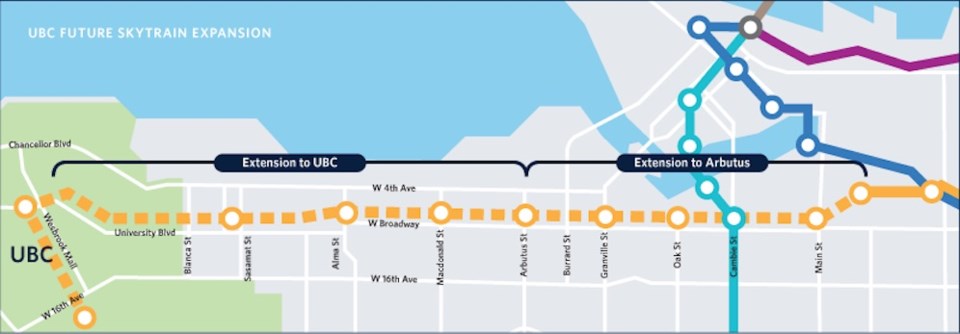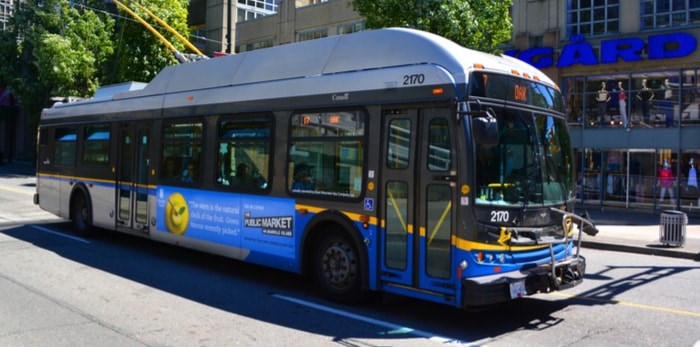Although the TransLink Mayors’ Council on Regional Transportation endorsed further study on a SkyTrain Millennium Line extension to the University of British Columbia (UBC), its recently released meeting minutes show that serving the university with a $7 billion subway is not a regional priority.
It is clear from the mayors’ discussion that raising funds for the next phase of transit projects would need significantly increased resources to meet the vast regional demands. Many mayors see equity as a major issue because �鶹��ýӳ��and UBC are considered already well served by transit relative to other municipalities that are growing rapidly but have little to no transit.
 Proposed extension of the Millennium Line to UBC (UBC Rapid Transit)
Proposed extension of the Millennium Line to UBC (UBC Rapid Transit)
The minutes say that “project costs must be borne by �鶹��ýӳ��and UBC as the line is not a regional priority.” So the municipal tax base will be used to fund transit, which is a provincial and federal funding responsibility, rather than funding the municipal services needed for a growing population.
More property taxes, development fees and a proposed land value capture tax would go to pay for a subway.
More rentals and affordable housing will not be achieved because the fees required to pay for the subway will need market strata development and much higher tower densities, like Oakridge and the Cambie corridor. Increased taxes will also make housing even more expensive.
Local businesses are already struggling. If the taxes don’t kill them, the business interruption from over a decade of subway construction will ensure most do not survive. It will also make commuting to UBC a nightmare.
A Broadway subway would make the Canada Line construction disruption on the Cambie corridor look like a dress rehearsal.
The main argument used to justify a subway is one of capacity, but this is mistaken. There are issues with both how ridership is calculated and how many could be served by only one subway along Broadway.
It is not accurate to count all ridership on 4th Avenue, Broadway, 16th, 25th, 33rd, 41st and 49th avenues and SW Marine Drive when determining potential ridership on a Broadway subway. People will continue to use the transit closest to them – especially if transit is plentiful and convenient.
 TransLink bus in �鶹��ýӳ��(meunierd / Shutterstock.com)
TransLink bus in �鶹��ýӳ��(meunierd / Shutterstock.com)
Also, the updated McElhanney Consulting Services report showed that multiple routes of transit were more effective at wooing people away from automobiles than just one subway on Broadway.
Most of the reports on Broadway rapid transit have been biased towards a SkyTrain subway and have a questionable involvement with SNC-Lavalin. There is no independent study showing what could be achieved with multiple routes of more affordable transit options. This should include express buses to take commuters from the Millennium and Expo lines directly to UBC, diverting ridership away from Broadway altogether.
�鶹��ýӳ��was built as a streetcar city before the common use of the automobile. It was designed to be transit oriented with short blocks that are all within a 10-minute walk of a streetcar arterial grid. These were later converted to the more flexible trolley buses that still serve the city today.
The most cost-effective electric transit option is to expand the existing trolley system at $1 million per kilometre and $1 million per articulated double trolley bus. Some light-rail transit along routes such as the Arbutus corridor could cost $50 million to $100 million per kilometre, compared with the subway at $500 million per kilometre.
Even the currently approved subway funding of $2.8 billion for only 5.8 kilometres could instead cover multiple routes of trolleys 13 kilometres each to UBC and still have funds left over for other priorities like affordable housing, including student housing at UBC.
There are more reasonable ways to serve UBC transit while still respecting regional municipal priorities.
Elizabeth Murphy ([email protected]) is a private-sector project manager and was formerly a property development officer for the City of Vancouver’s housing and properties department and for BC Housing.


